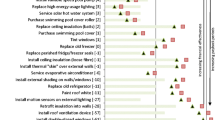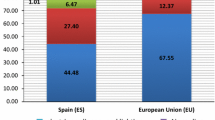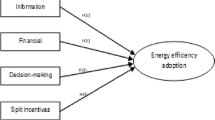Abstract
Energy efficiency is an effective strategy to reduce household energy consumption. Investments in energy efficiency measures (EEMs) result in reduced energy bills and increased comfort for households, while also contributing to national environmental targets. This article examines an energy efficiency scheme in Ireland and investigates the factors that determine investments in energy efficiency measures and the motivations of Irish households to participate in energy saving programs and adopt EEMs. The paper investigates three key research questions: the determination of investments in EEMs, with special focus on motivations and their relative importance; the consistency of motivations over the course of the decision-making process; and the consistency of determinants and motivations for investments in EEMs across different measures. The paper studies the implementation of seven energy efficiency measures in residential houses throughout Ireland. Results indicate that the decision to ultimately apply and invest in EEMs is mainly driven by monetary or economic factors such as gains in energy savings and the private cost of the measures. Comfort gains are found to be a secondary factor and environmental benefits of EEMs are found to be of little concern when making investment decisions. Finally, we suggest focusing on providing information about the benefits of the EEMs on energy savings and improvements in comfort in order to increase the adoption of EEMs by households in Ireland.

Similar content being viewed by others
Notes
The percentages are not required to add to 100 due to the possibility of multiple funding sources for a single measure.
The full decision-making framework of investment in EEMs starts earlier than the first stage considered in this paper. The decision process may start with the decision to retrofit and the evaluation of the type of retrofit the house needs. The very early stages of the decision-making process to invest in EEMs unfortunately cannot be analysed in this study due to lack of detailed information regarding different factors influencing the decision of going or not through the investment process. Therefore, we start the analysis of the investment’s decision-making process from the application stage.
This data is only available for households that have applied and obtained a grant from the authority. Unfortunately, we do not have the information on households that were not given a grant, and therefore, we cannot study their barriers or limitations.
The measure-specific effects are not strong enough. Gender is shown to be significant only for the case of upgrades in gas boilers, in which case the parameter presented a negative sign, indicating that women are more likely to adopt improvements in gas boilers than men. The age of the householders is only significant for the case of adoption of internal wall insulation; however, the effect is very small (0.7%).
References
Barr, S., Gilg, A. W., & Ford, N. (2005). The household energy gap: Examining the divide between habitual and purchase-related conservation behaviour. Energy Policy, 33, 1425–1444.
Black, J. S., Stern, P., & Elworth, J. (1985). Personal and contextual influences on household energy adaptations. Journal of Applied Psychology, 70, 3–21.
Caird, S., Roy, R., & Herring, H. (2008). Improving the energy performance of UK households: Results from surveys of consumer adoption and use of low- and zero-carbon technologies. Energy Efficiency, 1, 149–166.
Carlsmith, R., Chandler, W., McMahon, J., & Santino, D. (1990). Energy efficiency: How far can we go? Oak Ridge: Oak Ridge National Laboratory.
Claudy, M., & O’Driscoll, A. (2008). Beyond Economics – A behavioural approach to energy efficiency in domestic buildings. Euro-Asian Journal of Sustainable Energy Development Policy, 1, 27–40.
Clinch, J. P., & Healy, J. D. (2000). Domestic energy efficiency in Ireland: Correcting market failure. Energy Policy, 28, 1–8.
Costanzo, M., Archer, D., Aroson, E., & Pettigrew, T. (1986). Energy Conservation Behavior – The difficult path from information to action. American Psychologist, 41, 521–528.
Faiers, A., Cook, M., & Neame, C. (2007). Towards a contemporary approach for understanding consumer behaviour in the context of domestic energy use. Energy Policy, 35, 4381–4390.
Fowlie, M., Greenstone, M., & Wolfram, K. (2015). Are the Non-Monetary Costs of Energy Efficiency Investments Large? Understanding Low Take-up of a Free Energy Efficiency Program. American Economic Review: Papers and Proceedings, 105, 201–204.
Frederiks, E., Stenner, K., & Hobman, E. (2015). Household energy use: Applying behavioural economics to understand consumer decision-making and behaviour. Renewable and Sustainable Energy Reviews, 41, 1385–1394.
Gaskell, G., & Pike, R. (1983). Residental energy use: An investigation of consumers and conservation strategies. Journal of Consumer Policy, 6(3), 285–302.
Golove, W., & Eto, J.H. (1996). Market barriers to energy efficiency: A critical reappraisal of the rationale for public policies to promote energy efficiency. Report number LBL-38059 The Electricity Markets and Policy Group. Berkeley.
Gustavsson, L., & Joelsson, A. (2007). Energy conservation and conversion of electrical heating systems in detached houses. Energy and Buildings, 39, 717–726.
Henryson, J., Hakansson, T., & Pyrko, P. (2000). Energy efficiency in buildings through information - Swedish perspective. Energy Policy, 28, 169–180.
HES Scheme (2009). Home Energy Saving Scheme. SEI Application Guide. Application guide. Version 1.1. Sustainable Energy Ireland
Hoicka, C., Parker, P., & Andrey, J. (2014). Residential energy efficiency retrofits: How program design affects participation and outcomes. Energy Policy, 65, 594–607.
Jaffe, A., & Stavins, R. N. (1994). Energy-Efficiency investments and public policy. The Energy Journal, 15, 43–65.
Kastner, I., & Stern, P. (2015). Examining the decision-making processes behind household energy investments: A review. Energy Research & Social Science, 10, 72–89.
Lindenberg, S., & Steg, L. (2007). Normative, gain and hedonic goal-frames guiding environmental behaviour. Journal of Social Issues, 63, 117–137.
Mahapatra, K., & Gustavsson, L. (2008). An adopter-centric approach to analyze the diffusion patterns of innovative residential heating systems in Sweden. Energy Policy, 36, 577–590.
Motherway, B., & Halpin, T. (2010) Bringing Energy Home. Understanding how people think about energy in their homes. SEAI (Sustainable energy authority or Ireland) Report. September.
Nair, G., Gustavsson, L., & Mahapatra, K. (2010). Owners perception on the adoption of building envelope energy efficiency measures in Swedish detached houses. Applied Energy, 87, 2411–2419.
Oikonomou, V., Becchis, F., Steg, L., & Russolillo, D. (2009). Energy saving and energy efficiency concepts for policy making. Energy Policy, 37, 4787–4796.
Olsen, M. E. (1983). Public acceptance of consumer energy conservation strategies. Journal of Economic Psychology, 4, 183–196.
Otegbulu, A., Odekoya, A. J., & Johnson, O. (2012). Elixir Project Management, 51, 11159–11163.
Pollitt, M., & Shaorshadze, I. (2013). The role of behavioural economics in energy and climate policy. In R. Fouquet (Ed.), Handbook on Energy and Climate Change (Part IV). Edward Elgar Publishing. doi:10.4337/9780857933690.
Risholt, B., & Berker, T. (2013). Success for energy efficient renovation of dwellings – Learning from private homeowners. Energy Policy, 61, 1022–1030.
Rowlands, I. H., Scott, D., & Parker, P. (2003). Consumers and green electricity: Profiling potential purchasers. Business Strategy and the Environment, 12, 36–48.
Scheer, J., Durusut, E. and Foster, S. (2015). Unlocking the energy efficiency opportunity. Sustainable Energy Authority of Ireland (SEAI) report. Available at www.seai.ie.
Scott, S. (1997). Household energy efficiency in Ireland: A replication study of ownership of energy saving items. Energy Economics, 19, 187–208.
SEAI Report (2013). Energy in Ireland 1990-2012. Sustainable Energy Authority of Ireland.
Sorrell, S., O’Malley, E., Schleich, J., & Scott, S. (2004). The economics of energy efficiency – Barriers to cost-effective investment. Cheltenham: Edward Elgar Publishing.
Steg, L. (2008). Promoting household energy conservation. Energy Policy, 36, 4449–4453.
Stern, P. (1992). What psychology knows about energy conservation. American Psychologist, 47, 1224–1232.
Sutherland, R. (1991). Market barriers to energy-efficiency investments. The Energy Journal, 12, 15–34.
Sutterlin, B., Brunner, T., & Siegrist, M. (2011). Who puts the most energy into energy conservation? A segmentation of energy consumer based on energy-related behavioural characteristics. Energy Policy, 39, 8137–8152.
Williams, R., & Ross, M. (1980). Drilling for oil and gas in our houses. Technology Review, 82, 24–36.
Wilson, C., & Dowlatabadi, H. (2007). Models of decision making and residential energy use. Annual Review of Environment and Resources, 32, 169–203.
Wilson, C., Crane, L., & Chryssochoidis, G. (2015). Why do homeowners renovate energy efficiently? Contrasting perspectives and implications for policy. Energy Research and Social Science, 7, 12–22.
Zundel, S., & Stiess, I. (2011). Beyond profitability of energy-saving measures – Attitudes towards energy saving. Journal of Consumer Policy, 34, 91–105.
Acknowledgments
Claudia Aravena is funded under Programme for Research in Third Level Institutions and co-funded under the European Regional Development Fund (ERDF). We would like to thank Jim Sheer and the Sustainable Energy Authority of Ireland for providing the data and information for the development of this research. We would also like to thank Sean Lyons, Geertje Schuitema, two anonymous referees, participants to the Bergen Economics of Energy and Environment Research Conference, the 38th IAEE International Conference and the seminar at the Center for Environmental and Resource Economic Policy at North Carolina State University for helpful comments on previous versions of this paper. The usual disclaimer applies.
Author information
Authors and Affiliations
Corresponding author
Appendix
Rights and permissions
About this article
Cite this article
Aravena, C., Riquelme, A. & Denny, E. Money, Comfort or Environment? Priorities and Determinants of Energy Efficiency Investments in Irish Households. J Consum Policy 39, 159–186 (2016). https://doi.org/10.1007/s10603-016-9311-2
Received:
Accepted:
Published:
Issue Date:
DOI: https://doi.org/10.1007/s10603-016-9311-2




